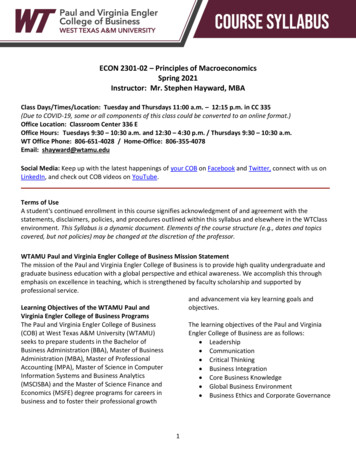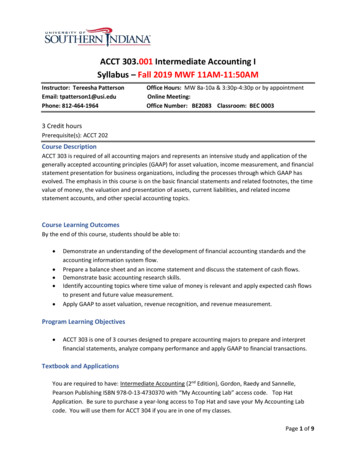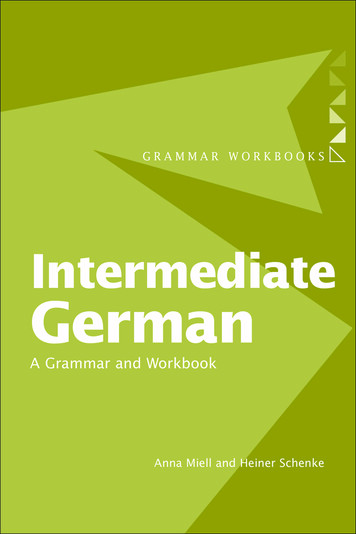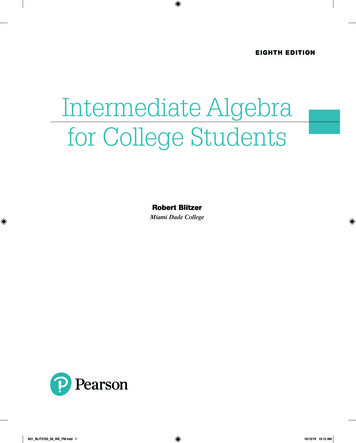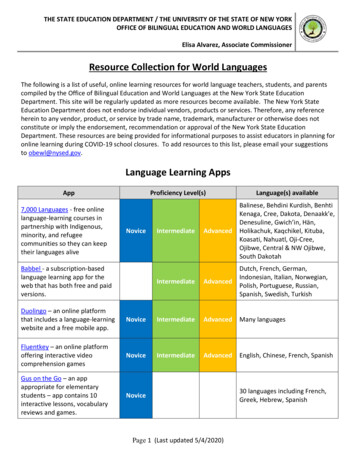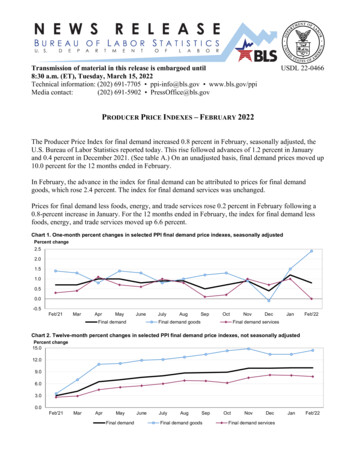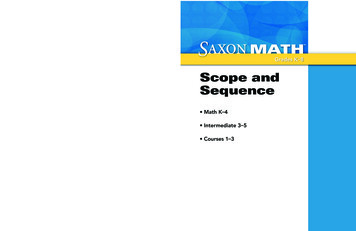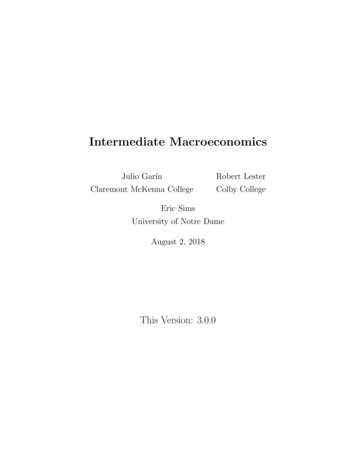
Transcription
Intermediate MacroeconomicsJulio Garı́nRobert LesterClaremont McKenna CollegeColby CollegeEric SimsUniversity of Notre DameAugust 2, 2018This Version: 3.0.0
This is a book designed for use in an intermediate macroeconomics course or a masterslevel course in macroeconomics. It could also be used by graduate students seeking a refresherin advanced undergraduate macroeconomics. This book represents a substantial makeoverand extension of the course notes for intermediate macroeconomics which have been providedpublicly on Eric Sims’s personal website for several years.There are many fine textbooks for macroeconomics at the intermediate level currentlyavailable. These texts include, but are certainly not limited to, Mankiw (2016), Williamson(2014), Jones (2013), Barro (1997), Abel, Bernanke, and Croushore (2017), Gordon (2012),Hall and Pappell (2005), Blanchard (2017), Dornbusch, Fischer, and Startz (2013), Froyen(2013), and Chugh (2015).Given the large number of high quality texts already on the market, why the need fora new one? We view our book as fulfilling a couple of important and largely unmet needsin the existing market. First, our text makes much more use of mathematics than mostintermediate books. Second, whereas most textbooks divide the study of the macroeconomyinto two “runs” (the long run and the short run), we focus on three runs – the long run, themedium run, and the short run. Third, we have attempted to emphasize the microeconomicunderpinnings of modern macroeconomics, all the while maintaining tractability and a focuson policy. Fourth, we include a section on banking, bank runs, bond pricing, and the stockmarket. While this material is generally left to money, credit, and banking texts, the recentGreat Recession has taught us the importance of thinking seriously about the implicationsof the financial system for the macroeconomy. Finally, we feel that a defining feature ofthis text is that it is, if nothing else, thorough – we have tried hard to be very clear aboutmathematical derivations and to not skip steps when doing them.Modern economics is increasingly quantitative and makes use of math. While it isimportant to emphasize that math is only a tool deployed to understand real-world phenomena,it is a highly useful tool. Math clearly communicates ideas which are often obfuscated whenonly words are used. Math also lends itself nicely to quantitative comparisons of modelswith real-world data. Our textbook freely makes use of mathematics, more so than mostof the texts we cited above. An exception is Chugh (2015), who uses more math than wedo. To successfully navigate this book, a student needs to be proficient at high school levelalgebra and be comfortable with a couple of basic rules of calculus and statistics. We haveincluded Appendices A and B to help students navigate the mathematical concepts whichare used throughout the book. While we find the approach of freely integrating mathematicsinto the analysis attractive, we recognize that it may not be well-suited for all students andall instructors. We have therefore written the book where the more involved mathematicalanalysis is contained in Part III. This material can be skipped at the instructor’s discretion,1
which allows an instructor to spend more time on the more graphical analysis used in PartsIV and V.Traditionally, macroeconomic analysis is divided into the “long run” (growth) and the“short run” (business cycles). We have added a third run to the mix, which we call the“medium run.” This is similar to the approach in Blanchard (2017), although we reverseordering relative to Blanchard, studying the long run first, then the medium run, then theshort run. Our principal framework for studying the long run in Part II is the canonical Solowmodel. We are attracted to this framework because it clearly elucidates the important role ofproductivity in accounting for both long run growth and cross-country income differences. Adrawback is that the Solow model does not formally model microeconomic decision-making,as we do throughout the rest of the book. To that end, we have also included Chapter 8using an overlapping generations framework with optimizing agents. This framework toucheson many of the same issues as the Solow model, but allows us to address a number of otherissues related to efficiency and the role of a government.Whereas growth theory studies the role of capital accumulation and productivity growthover the span of decades, we think of the medium run as focusing on frequencies of timemeasured in periods of several years. Over this time horizon, investment is an importantcomponent of fluctuations in output, but it is appropriate to treat the stock of physicalcapital as approximately fixed. Further, nominal frictions which might distort the short runequilibrium relative to an efficient outcome are likely not relevant over this time horizon.Our framework for studying the medium run is what we call the neoclassical model (or realbusiness cycle model). In this framework, output is supply determined and the equilibrium isefficient. The microeconomic underpinnings of the neoclassical model are laid out in Part IIIand a full graphical treatment is given in Part IV.We think of the short run as focusing on periods of time spanning months to several years.Our framework for studying the short run is a New Keynesian model with sticky prices. Thisanalysis is carried out in Part V. The only difference between our medium and short runmodels is the assumption of price rigidity, which makes the AS curve non-vertical – otherwisethe models are the same. We consider two different versions of the sticky price model – onein which the price level is completely predetermined within period (the simple sticky pricemodel) and another in which the price level is sensitive to the output gap (the partial stickyprice model). With either form of price stickiness, demand shocks matter, and the scope forbeneficial short run monetary and/or fiscal policies becomes apparent. Optimal monetarypolicy and complications raised by the zero lower bound (ZLB) are addressed. Appendix Ddevelops a sticky wage model which has similar implications to the sticky price model.Modern macroeconomics is simply microeconomics applied at a high level of aggregation.2
To that end, we have devoted an entire part of the book, Part III, to the “Microeconomics ofMacroeconomics.” There we study an optimal consumption-saving problem, a firm profitmaximization problem in a dynamic setting, equilibrium in an endowment economy, anddiscuss fiscal policy, money, and the First Welfare Theorem. Whereas for the most part weignore unemployment throughout the book and instead simply focus on total labor input, wealso include a chapter on search, matching, and unemployment. The analysis carried out inPart III serves as the underpinning for the remainder of the medium and short run analysisin the book, but we have tried to write the book where an instructor can omit Part III shouldhe or she choose to do so.Relatedly, modern macroeconomics takes dynamics seriously. We were initially attractedto the two period macroeconomic framework used in Williamson (2014), for which Barro(1997) served as a precursor. We have adopted this two period framework for Parts III throughV. That said, our experience suggested that the intertemporal supply relationship (due toan effect of the real interest rate on labor supply) that is the hallmark of the Williamson(2014) approach was ultimately confusing to students. It required spending too much timeon a baseline market-clearing model of the business cycle and prevented moving more quicklyto a framework where important policy implications could be addressed. We have simplifiedthis by assuming that labor supply does not depend on the real interest rate. This can bemotivated formally via use of preferences proposed in Greenwood, Hercowitz, and Huffman(1988), which feature no wealth effect on labor supply.We were also attracted to the timeless IS-LM approach as laid out, for example, soeloquently by Mankiw (2016), Abel, Bernanke, and Croushore (2017), and others. Part Vstudies a short run New Keynesian model, freely making use of the commonly deployedIS-LM-AD-AS analysis. The medium run model we develop graphically in part IV can becast in this framework with a vertical AS curve, which is often called the “long run supplycurve” (or LRAS) in some texts. Because of our simplification concerning the dynamic natureof labor supply in Part IV, we can move to the short run analysis in Part V quicker. Also,because the medium run equilibrium is efficient and the medium run can be understood as aspecial case of the short run, the policy implications in the short run become immediatelyclear. In particular, policy should be deployed in such a way that the short run equilibrium(where prices are sticky) coincides with the medium run equilibrium. Price stability is oftena good normative goal, and monetary policy ought to target the natural or neutral rateof interest, which is the interest rate which would obtain in the absence of price or wagerigidities. This “Wicksellian” framework for thinking about policy is now the dominantparadigm for thinking about short run fluctuations in central banks. Within the context ofthe IS-LM-AD-AS model, we study the zero lower bound and an open economy version of3
the model. Jones (2013) proposes replacing the LM curve with the monetary policy (MP)curve, which is based on a Taylor rule type framework for setting interest rates. We includean appendix, Appendix E, where the MP curve replaces the LM curve.Finally, the recent Great Recession has highlighted the importance of thinking aboutconnections between the financial system and the macroeconomy. Part VI of the book isdedicated to studying banking, financial intermediation, and asset pricing in more depth. Weinclude chapters on the basics of banking and bank runs, as well as a chapter that delves intothe money supply process in more detail. We also have detailed chapters on bond and stockpricing in a dynamic, optimizing framework based on the stochastic discount factor. Much ofthis material is traditionally reserved for money, credit, and banking courses, but we thinkthat recent events make the material all the more relevant for conventional macroeconomicscourses. Chapter 35 incorporates an exogenous credit spread variable into our medium/shortrun modeling framework and argues that exogenous increases in credit spreads are a sensibleway to model financial frictions and crises. Chapter 36 provides an in-depth accounting of therecent financial crisis and Great Recession and deploys the tools developed elsewhere in thebook to understand the recession and the myriad policy interventions undertaken in its wake.In writing this book, we have tried to follow the lead of Glenmorangie, the distillerymarketing itself as producing Scotch that is “unnecessarily well-made.” In particular, wehave attempted throughout the book to be unnecessarily thorough. We present all the stepsfor various mathematical derivations and go out of our way to work through all the stepswhen deriving graphs and shifting curves. This all makes the book rather than longer thanit might otherwise be. In a sense, it is our hope that a student could learn from this textwithout the aid of a formal instructor, though we think this is suboptimal. Our preferencefor this approach is rooted in our own experiences as students, where we found ourselvesfrustrated (and often confused) when instructors or textbooks skipped over too many details,instead preferring to focus on the “big picture.” There is no free lunch in economics, andour approach is not without cost. At present, the book is short on examples and real-worldapplications. We hope to augment the book along these dimensions in the coming monthsand years. The best real world examples are constantly changing, and this is an area wherethe instructor contributes some value added, helping to bring the text material to life.The book is divided into six main parts. Part I serves as an introduction. Chapter 1reviews some basic definitions of aggregate macroeconomic variables. While most studentsshould have seen this material in a principles course, we think it is important for them tosee it again. Chapter 2 defines what an economic model is and why a model is useful. Thischapter motivates the rest of the analysis in the book, which is based on models. Chapter 3provides a brief overview of the history and controversies of macroeconomics.4
We study the long run in Part II. We put the long run first, rather than last as in manytextbooks, for two main reasons. First, growth is arguably much more important for welfarethan is the business cycle. As Nobel Prize winner Robert Lucas once famously said, “Once youstart to think about growth, it is difficult to think about anything else.” Second, the standardSolow model for thinking about growth is not based on intertemporal optimization, butrather assumes a constant saving rate. This framework does not fit well with the remainderof the book, which is built around intertemporal optimization. Nevertheless, the Solow modeldelivers many important insights about both the long run trends of an economy and thesizeable cross-country differences in economic outcomes. Chapter 4 lays out some basicfacts about economic growth based on the contribution of Kaldor (1957). Chapter 5 studiesthe textbook Solow model. Chapter 6 considers an augmented version of the Solow modelwith exogenous productivity and population growth. Chapter 7 uses the Solow model toseek to understand cross-country differences in income. In the most recent edition of thebook, we have also included a chapter using a dynamic, optimizing, overlapping generationsframework (Chapter 8). While touching on similar issues to the Solow model, it allows todiscuss things like market efficiency and potentially beneficial roles of a government. Thoughit ends up having similar implications as the Solow model, because the OLG economy featuresoptimizing households in the context of a growth model, it provides a nice bridge to laterparts of the book.Part III is called the “Microeconomics of Macroeconomics” and studies optimal decisionmaking in a two period, intertemporal framework. This is the most math-heavy componentof the book, and later parts of the book, while referencing the material from this part, aremeant to be self-contained. Chapter 9 studies optimal consumption-saving decisions in atwo period framework, making use of indifference curves and budget lines. It also considersseveral extensions to the two period framework, including a study of the roles of wealth,uncertainty, and liquidity constraints in consumption-saving decisions. Chapter 10 extendsthis framework to more than two periods. Chapter 11 introduces the concept of competitiveequilibrium in the context of the two period consumption-saving framework, emphasizing thatthe real interest rate is an intertemporal price which adjusts to clear markets in equilibrium.It also includes some discussion on heterogeneity and risk-sharing, which motivates the useof the representative agent framework used throughout the book. Chapter 12 introducesproduction, and studies optimal labor and investment demand for a firm and optimal laborsupply for a household. Chapter 13 introduces fiscal policy into this framework. Here wediscuss Ricardian Equivalence, which is used later in the book, but also note the conditionsunder which Ricardian Equivalence will fail to hold. Chapter 14 introduces money intothe framework, motivating the demand for money through a money in the utility function5
assumption. Here we do not go into detail on the money creation process, instead reservingthat material for later in the book (Chapter 31). Chapter 15 discusses the equivalence of thedynamic production economy model laid out in Chapter 12 to the solution to a social planner’sproblem under certain conditions. In the process we discuss the First Welfare Theorem.Although we are mostly silent on unemployment, Chapter 16 includes a microeconomicallyfounded discussion of unemployment using the Diamond-Mortensen-Pissarides framework.The medium run is studied in Part IV. We refer to our model for understanding the mediumrun as the neoclassical model. It is based on the intertemporal frictionless production economystudied in more depth in Chapter 12, though the material is presented in such a way as to beself-contained. Most of the analysis is graphical in nature. The consumption, investment,money, and labor demand schedules used in this part come from the microeconomic decisionmaking problems studied in Part III, as does the labor supply schedule. Chapter 17 discussesthese decision rules and presents a graphical depiction of the equilibrium, which is based on atraditional IS curve summarizing the demand side and a vertical curve which we will the Y scurve (after Williamson 2014) to describe the supply-side. The Y s curve is vertical, ratherthan upward-sloping in a graph with the real interest rate on the vertical axis and output onthe horizontal, because of our assumption of no wealth effects on labor supply. AppendixC carries out the analysis where the Y s curve is instead upward-sloping, as in Williamson(2014). Chapter 18 graphically works through the effects of changes in exogenous variables onthe endogenous variables of the model. Chapter 19 presents some basic facts about observedbusiness cycle fluctuations and assesses the extent to which the neoclassical model can providea reasonable account of those facts. In Chapter 20 we study the connection between themoney supply, inflation, and nominal interest rates in the context of the neoclassical model.Chapter 21 discusses the policy implications of the model. The equilibrium is efficient, andso there is no scope for policy to attempt to combat fluctuations with monetary or fiscalinterventions. In this chapter we also include an extensive discussion of criticisms which havebeen levied at the neoclassical / real business cycle paradigm for thinking about economicpolicy. Chapter 22 considers an open economy version of the neoclassical model, studyingnet exports and exchange rates.Part V studies a New Keynesian model. This model is identical to the neoclassicalmodel, with the exception that the aggregate price level is sticky. This stickiness allowsdemand shocks to matter and means that money is non-neutral. It also means that the shortrun equilibrium is in general inefficient, opening the door for desirable policy interventions.Chapter 23 develops the IS-LM-AD curves to describe the demand side of the model. Whatdifferentiates the New Keynesian model from the neoclassical model is not the demand side,but rather the supply side. Hence, the IS-LM-AD curves can also be used to describe the6
demand side of the neoclassical model. We prefer our approach of first starting with the IS-Y scurves because it better highlights monetary neutrality and the classical dichotomy. Chapter24 develops a theory of a non-vertical aggregate supply curve based on price stickiness.An appendix develops a New Keynesian model based on wage stickiness rather than pricestickiness, Appendix D. Chapter 25 works out the effects of changes in exogenous variableson the endogenous variables of the New Keynesian model and compares those effects tothe neoclassical model. Chapter 26 develops a theory of the transition from short run tomedium run. In particular, if the short run equilibrium differs from what would obtainin the neoclassical model, over time pressure on the price level results in shifts of the ASrelationship that eventually restore the neoclassical equilibrium. On this basis we providetheoretical support for empirically observed Phillips Curve relationships. In Chapter 27 westudy optimal monetary policy in the Keynesian model. The optimal policy is to adjust themoney supply / interest rates so as to ensure that the equilibrium of the short run modelcoincides with the equilibrium which would obtain in the absence of price rigidity (i.e. theneoclassical, medium run equilibrium). Here, we talk about the Wicksellian “natural” or“neutral” rate of interest and its importance for policy. We also discuss the benefits of pricestability. Chapter 28 studies the New Keynesian model when the zero lower bound is binding.Chapter 29 considers an open economy version of the New Keynesian model.Recent events have highlighted the important connection between finance and macroeconomics. Part VI is dedicated to these issues. Chapter 30 discusses the basic businessof banking and focuses on bank balance sheets. There we also discuss how banking haschanged in the last several decades, discussing the rise of a so-called “shadow banking” sector.Chapter 31 studies the creation of money and defines terms like the monetary base andthe money multiplier. Chapter 32 discusses the usefulness of the liquidity transformationin which financial intermediaries engage and the sensitivity of financial intermediaries toruns. To that end, we provide a simplified exposition of the classic Diamond and Dybvig(1983) model of bank runs. This material proves useful in thinking about the recent financialcrisis. Chapters 33 and 34 study asset pricing in the context of a microeconomically foundedconsumption capital asset pricing model (CAPM) based on the stochastic discount factor.Chapter 33 studies the risk and term structures of interest rates and provides a frameworkfor thinking seriously about both conventional and unconventional monetary policy. Chapter34 studies the stock market and seeks to understand the equity premium. We also discussthe possibility of bubbles and whether policy ought to try to prevent them.Although much research has been recently done, it is not straightforward to incorporate anon-trivial financial system in a compelling and tractable way into an otherwise standardmacroeconomic framework. In Chapter 35, we argue that a convenient short cut is to include7
an exogenous credit spread variable which we label ft . This spread represents a premiumfirms must pay to finance investment over the return households receive on saving. It servesas a convenient stand-in for both the risk and term structures of interest rates. We arguethat financial crises are best characterized as runs on liquidity which result in large increasesin credit spreads. In terms of the IS-LM-AD-AS model, an increase in the exogenous creditspread variable shifts the IS and AD curves in to the left. In Chapter 36 we study financialcrises more generally with a particular focus on the recent Great Recession. The presentationof this chapter ought to be at least somewhat self-contained, but it does make use of conceptsstudied in detail in Parts V and VI. We present facts, talk about the conventional wisdomconcerning the origins of the crisis, map those origins into our New Keynesian framework,and then use that framework to think about the myriad unconventional policy measureswhich were deployed.We realize that there is likely too much material presented here for a normal one semestercourse. It is our hope that our approach of presenting the material in as thorough as possiblea manner will facilitate moving through the material quickly. As alluded to above, there area number of different ways in which this book can be used. Part I could be skipped entirely,an instructor could have a teaching assistant work through it, or an instructor could requirestudents to read the material on their own without devoting scarce class time to it. Forstudying growth, it may suffice to only focus on Chapter 5, skipping the augmented Solowmodel with exogenous productivity and population growth and/or the chapter on overlappinggenerations. Chapter 7 is written in such a way that the material in Chapter 6 need not havepreviously been covered.Some instructors may see fit to skip all or parts of Part III. One option for condensingthis material would be to skip Chapters 10 (which considers a multi-period extension ofthe two period consumption-saving model), 11 (which studies equilibrium in an endowmenteconomy), or parts of Chapters 14 through 15. In Parts IV and V, one can condense thematerial by skipping the open economy chapters, Chapters 22 and 29. The book can betaught without any reference at all to the material in Part VI. Some instructors may find itsuitable to substitute this material for other chapters. As this book is a work in progress, wetoo are experimenting with how to best structure a course based on this book, and wouldappreciate any feedback from instructors who have tried different course structures elsewhere.Throughout the book, we include hyperlinked references to academic papers and otherreadings. These are denoted in blue and appear in the format “Name (year of publication).”For many publications, the references section includes hyperlinks to the papers in question.We also include hyperlinks to other external readings, in many cases Wikipedia entrieson topics of interest. These are also indicated in blue, and in the online version can be8
navigated to with a simple click. At the conclusion of each chapter, we include two sets ofproblems – one is called “Questions for Review” and requires mostly short written responseswhich simply review the material presented in the text, while the other is called “Exercises”and typically features longer problems requiring students to work through mathematical orgraphical derivations, often times including extensions of the models presented in the text.Modern macroeconomics is quantitative, and quantitative skills are increasingly valued inmany different types of jobs. To that end, we include several questions which require thestudents to work with data (either actual or artificial) using Microsoft Excel. These aredemarcated with the indicator “[Excel problem]”.We are grateful to several generations of undergraduate students at the University ofNotre Dame, the University of Georgia, Claremtont McKenna College, and Colby Collegewho have taken intermediate macro courses using early versions of the course notes whicheventually grew into this book. Their comments and feedback have improved the presentationand content of the resulting material. Ultimately, our students – past and future ones – arethe reason we wrote this text. We are also grateful to Michael Pries for extensive commentson an earlier draft of this book.We welcome any feedback on the textbook. As it is a work in progress, the manuscript isalmost surely littered with typos and sections that may not be perfectly clear. If you havecomments or suggestions along any of these lines, please email them to us at the addressesgiven below.Julio Garı́nClaremont McKenna Collegejgarin@cmc.eduRobert LesterColby Collegerblester@colby.eduEric SimsUniversity of Notre Dameesims1@nd.edu9
ContentsIIntroduction1 Macroeconomic Data1.1 Calculating GDP . . . . . . .1.2 Real versus Nominal . . . . .1.3 The Consumer Price Index .1.4 Measuring the Labor Market1.5 Summary . . . . . . . . . . .21.2323283436402 What is a Model?452.1 Models and Why Economists Use Them . . . . . . . . . . . . . . . . . . . . . . . 452.2 Summary . . . . . . . . . . . . . . . . . . . . . . . . . . . . . . . . . . . . . . . . . 473 Brief History of Macroeconomic Thought3.1 The Early Period: 1936-1968 . . . . . . . . .3.2 Blowing Everything Up: 1968-1981 . . . . .3.3 Modern Macroeconomics: 1982-2016 . . . .3.4 Summary . . . . . . . . . . . . . . . . . . . .IIThe Long Run.4949505254554 Facts About Economic Growth584.1 Economic Growth over Time: The Kaldor Facts . . . . . . . . . . . . . . . . . . 584.2 Cross Country Facts . . . . . . . . . . . . . . . . . . . . . . . . . . . . . . . . . . . 674.3 Summary . . . . . . . . . . . . . . . . . . . . . . . . . . . . . . . . . . . . . . . . . 705 The5.15.25.3Basic Solow Model73Production, Consumption, and Investment . . . . . . . . . . . . . . . . . . . . . 73Graphical Analysis of the Solow Model . . . . . . . . . . . . . . . . . . . . . . . . 82The Algebra of the Steady State with Cobb-Douglas Production . . . . . . . . 8910
5.45.55.6Experiments: Changes in s and A . . . . . . . . . . . . . . . . . . . . . . . . . . . 89The Golden Rule . . . . . . . . . . . . . . . . . . . . . . . . . . . . . . . . . . . . . 97Summary . . . . . . . . . . . . . . . . . . . . . . . . . . . . . . . . . . . . . . . . . 1026 The6.16.26.36.46.56.66.7Augmented Solow ModelIntroducing Productivity and Population GrowthGraphical Analysis of the Augmented Model . . .The Steady State of the Augmented Model . . . .Experiments: Changes in s and A . . . . . . . . . .The Golden Rule . . . . . . . . . . . . . . . . . . . .Will Economic Growth Continue Indefinitely? . .Summary . . . . . . . . . . . . . . . . . . . . . . . .7 Understanding Cross-Country Income Differences7.1 Convergence . . . . . . . . . . . . . . . . . . . . . . . . . . . . . . . . . . . .7.1.1 Conditional Convergence . . . . . . . . . . . . . . . . . . . . . . . .7.2 Can Differences in s Account for Large Per Capita Output Differences?7.3 The Role of Productivity . . . . . . . . . . . . . . . . . . . . . . . . . . . .7.4 Summary . . . . . . . . . . . . . . . . . . . . . . . . . . . . . . . . . . . . .8 Overlapping Generations8.1 The General Overlapping Generations Model . . . .8.1.1 Households . . . . . . . . . . . . . . . . . . . .8.1.2 Firm . . . . . . . . . . . . . . . . . . . . . . . .8.1.3 Equilibrium and Aggregation . . . . . . . . .8.2 Cobb-Douglas Production and Logarithmic Util
intermediate books. Second, whereas most textbooks divide the study of the macroeconomy into two \runs" (the long run and the short run), we focus on three runs { the long run, the medium run, and the short run
